October 3-10, 2001
The Big Travelogue: Part Six
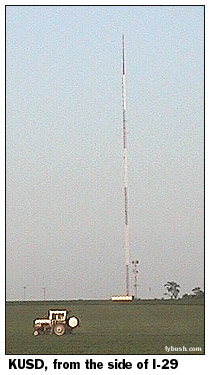 There's nothing
like a good road trip to get a feel for the state of radio these
days. From June 23 until July 7, your editor (accompanied by
Boston Radio Archives creator Garrett Wollman) hit the road to
see what's on - and in - the air across a broad swath of mid-America. There's nothing
like a good road trip to get a feel for the state of radio these
days. From June 23 until July 7, your editor (accompanied by
Boston Radio Archives creator Garrett Wollman) hit the road to
see what's on - and in - the air across a broad swath of mid-America.
For the next few installments of Site of the Week, we'll be
recapping the many highlights of what we like to think of as
The Big Trip, 2001 edition. Come along...
Click
here for part one
Click
here for part two
Click
here for part three
Click
here for part four
Click
here for part five
Thursday, June 28 - It's been a very long day on the
road, starting out back in Des Moines and taking us through Ames,
Boone, Fort Dodge, Storm Lake and Sioux City, and we're not done
yet. Crossing the South Dakota line around 6 PM, we're still
half an hour away from our motel for the night, in the college
town of Vermillion - and after setting up the VCRs, we're off
for a few more hours of tower-hunting, thanks to the long, long
days of the Midwestern summer (sunset is listed tonight for 9:35
PM!)
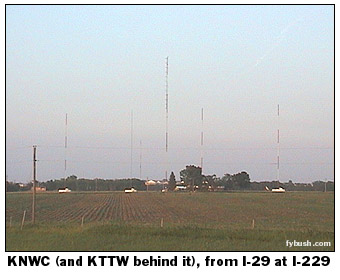 It's about an hour
from Vermillion up to Sioux Falls, and we're making good time
in spite of massive construction that has an entire side of I-29
closed. It's about an hour
from Vermillion up to Sioux Falls, and we're making good time
in spite of massive construction that has an entire side of I-29
closed.
Our first two sites are glimpsed quickly from the car, beginning
with a tall TV tower about halfway between Vermillion and Sioux
Falls. This is KUSD-TV 2 and KUSD-FM 89.7, the flagships of the
South Dakota public broadcasting network.
Just before we turn from I-29 on to I-229, the loop road around
Sioux Falls, we pull off again for a view that takes in two sites.
In the foreground, just east of the interchange, we see the four
towers of KNWC(AM) 1270 and the taller tower of KNWC-FM 96.5,
the Sioux Falls outlets of Northwestern College's religious radio
chain in the upper Midwest. Look carefully to the left of the
KNWC-FM tower and you'll see another stick off in the distance,
that of Fox affiliate KTTW (Channel 17).
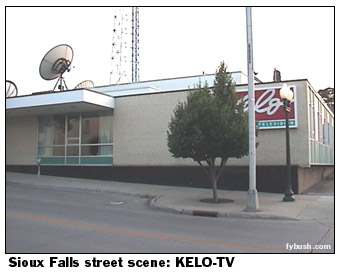 A quick stop at
the suburban office park that houses NBC affiliate KDLT-TV (Channel
46)'s studios, and we're off to downtown, all the while recounting
the story of how KORN-TV (Channel 5) 60 miles west in Mitchell,
S.D. became KDLT-TV, serving both cities from a tower halfway
between them, then won the license for Channel 46 in Sioux Falls,
moving Channel 5 to the other side of Mitchell under the new
calls KDLV. A quick stop at
the suburban office park that houses NBC affiliate KDLT-TV (Channel
46)'s studios, and we're off to downtown, all the while recounting
the story of how KORN-TV (Channel 5) 60 miles west in Mitchell,
S.D. became KDLT-TV, serving both cities from a tower halfway
between them, then won the license for Channel 46 in Sioux Falls,
moving Channel 5 to the other side of Mitchell under the new
calls KDLV.
On South Phillips Avenue downtown, we find the studios of
Sioux Falls' top TV station, KELO-TV (Channel 11), which feeds
a network of satellite stations in towns like Reliance (and as
far away as Rapid City, on the other end of the state) with CBS
programming and statewide news. (Pronounce it "Kello,"
as in "hello," if you want to sound like a local!)
Across the street sits another building that's home to former
sister stations KELO AM/FM (1320/92.5) and the rest of the Mid-Continent
Broadcasting radio cluster. (Mid-Continent had to sell the TV
stations when it bought most of the state's cable companies a
few years back...)
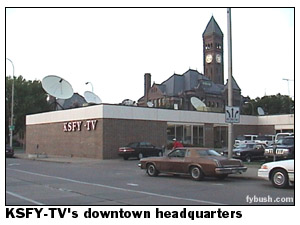 A few blocks away
on North Dakota Avenue, attached to a hotel, we find the ABC
affiliate, KSFY-TV (Channel 13), the former KSOO-TV from years
gone by. A few blocks away
on North Dakota Avenue, attached to a hotel, we find the ABC
affiliate, KSFY-TV (Channel 13), the former KSOO-TV from years
gone by.
Like KELO, KSFY serves most of the state, with a satellite
transmitter in the state capital of Pierre, KPRY-TV (Channel
4).
(Rapid City does have its own ABC affiliate, which observes
the local Mountain Time Zone while the KELO relay runs the Central
Time Zone schedule that's two hours earlier. As a bizarre result,
CBS prime time in Rapid City begins at 6 PM and ends at 9, with
Letterman at 9:35 and Craig Kilborn at 10:35. TV viewers in western
South Dakota must be awfully confused!)
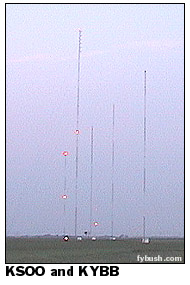 With darkness fast
approaching (it's after 8 o'clock already), we head back south
to the big cluster of sites that sits on the Iowa border a few
miles southeast of downtown. With darkness fast
approaching (it's after 8 o'clock already), we head back south
to the big cluster of sites that sits on the Iowa border a few
miles southeast of downtown.
From a distance, we can see the five towers of KSOO (1140),
with the tall tower also holding FM bays for KYBB (102.7). Look
very carefully at the middle of the array and you might be able
to see the beacon of yet another tower to the south, that of
KRRO (103.7), which is also home to sports station KWSN (1230).
(Even on that graveyard channel, the incredible ground conductivity
in the region will make KWSN an easy listen the next morning
70 miles away in Vermillion!)
A couple of miles to the east, we pull up at one of the most
curious sites we'll see on this trip.
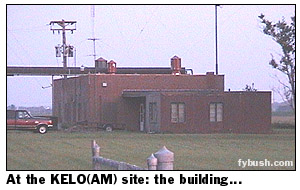 The
KELO(AM) site is clearly an old one, at least judging by the
big brick transmitter house. (Despite the truck parked in front,
we saw no evidence anyone was inside, or else we'd have asked
for a tour...) The
KELO(AM) site is clearly an old one, at least judging by the
big brick transmitter house. (Despite the truck parked in front,
we saw no evidence anyone was inside, or else we'd have asked
for a tour...)
The actual AM array is a fairly typical three-tower deal,
though the towers seemed rather tall for 1320 (with a signal
to match; this station gets out incredibly well towards Vermillion).
But look at the top of that building: that's a huge transmission
line extending to the east over the 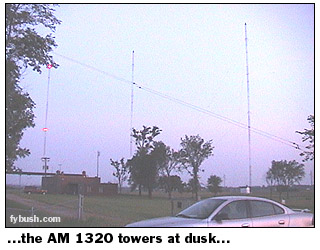 parking
lot, to another tower on the edge of the property that seems
awfully heavily guyed for a short stick. parking
lot, to another tower on the edge of the property that seems
awfully heavily guyed for a short stick.
(You can see the guy wires crossing in front of the AM array
in the picture to the right, which also includes the trusty Pontiac
Grand Am rental that carried us thousands of miles to the midwest
and back home...)
Garrett is the first to notice the FM bays lurking within
the broad faces of the tower, which we surmise to be a KELO-FM
backup, and soon we have the mystery more or less solved: this
is the original KELO-TV tower, which must once have risen much
higher (I've since seen pictures of the tower in its original
state, and it was at least a thousand feet) but has since been
chopped off a couple hundred feet up.
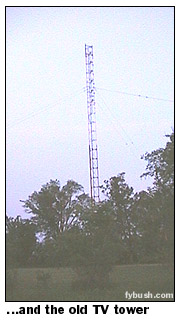 A short
distance to the east are the towers of KXRB (1000), a country-music
daytimer, which we see but don't photograph. A short
distance to the east are the towers of KXRB (1000), a country-music
daytimer, which we see but don't photograph.
By now, it's getting dark indeed (you should see what some
of these pictures looked like straight out of the digital camera!),
and we're forced to scrub some of the "extra" parts
of the trip, including the AM 1520 stick northwest of town and
a hoped-for jaunt 12 miles down I-90 east to add Minnesota to
our list of states visited.
Instead, we use the last rays of daylight to follow highway
17 east towards the Iowa line, where we see the impressively
tall Sioux Falls TV towers, a cluster of four sticks that each
push the 2000-foot mark, including one shared by KSFY and KELO-TV/FM,
another for KDLT, and one that we believe to be a new DTV-ready
tower. It's too dark to get a good picture, so we call it a night
(it's almost 10 o'clock by now) and head back towards the city
for some dinner.
Nightlife and Sioux Falls aren't necessarily compatible concepts,
and in the end we're forced to concede to our one and only McDonald's
stop of the trip, followed by an hour back down I-29 to Vermillion,
where the VCRs have been whirring away on newscasts from Sioux
Falls and Sioux City.
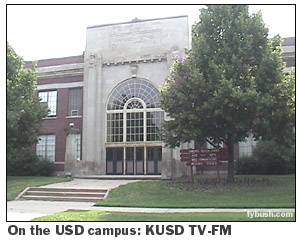 Friday,
June 29 - Our motel on Cherry Street is just a couple of
blocks from the University of South Dakota campus, where we find
the studios of South Dakota Public TV and South Dakota Public
Radio in this building that looks more like somebody's high school. Friday,
June 29 - Our motel on Cherry Street is just a couple of
blocks from the University of South Dakota campus, where we find
the studios of South Dakota Public TV and South Dakota Public
Radio in this building that looks more like somebody's high school.
The USD student station, KAOR 91.1, appears to be off for
the summer, and we don't see its antenna anywhere obvious, so
we head off to chase a bit of history.
KUSD, you see, began as an AM outlet, a daytimer on 690 kHz
that survived into the 1980s. We have its tower coordinates plotted
out just north of town, and we arrive there to find a short stick
that looks like it might once have been the bottom of an AM 690
tower.
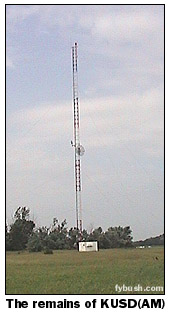 We think KUSD-FM
was once here too, and perhaps the TV as well, before building
the new high-powered site far to the north that reaches into
Sioux City as well (although SDPTV and SDPR now have lower-powered
relay transmitters in Sioux City itself). We think KUSD-FM
was once here too, and perhaps the TV as well, before building
the new high-powered site far to the north that reaches into
Sioux City as well (although SDPTV and SDPR now have lower-powered
relay transmitters in Sioux City itself).
Our final stop in Vermillion is on the main drag (old route
50) through town, where we see the studios of KOSZ (1570) and
KVHT (106.3) and a sign that would make many a zoning board blanch
(but does our hearts proud...)
(You can't see it in the still picture, but the blue and red
lettering on the "boom boxes" is actually made up of
little spangly shiny things that shimmer in the sunlight and
just look really, well, neat.)
From here, we head west on route 50 to what amounts to this
trip's Holy Grail: the legendary farm voice of WNAX, Yankton.
We're full of anticipation, but we can't even imagine how good
that visit will be - and we're out of time and space this week,
so it will be the focus of Part Seven next week, as we get ourselves
back on schedule from some disruptions caused first by the September
11 attacks and then by some ISP problems that are finally close
to being resolved.
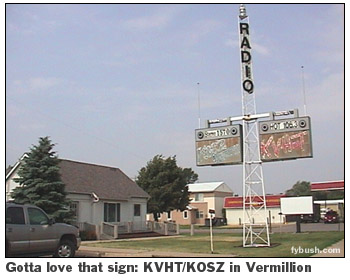 And
while you wait for our WNAX trip, a few words about our newest
venture here at fybush.com: And
while you wait for our WNAX trip, a few words about our newest
venture here at fybush.com:
If you enjoy Site of the Week on the Web, we're hoping you'll
love our Tower Site 2002 Calendar!
This full-color calendar will feature a dozen of our favorite
sites, including several from last summer's Big Trip - not to
mention monthly calendars that include all the really important
dates like WHAM's 80th anniversary and Edwin Armstrong's birthday.
If you're a regular Site of the Week reader, we have a feeling
you'll have to have the calendar, too. We'll print only enough
to fill orders received by October 29, so don't delay! The Tower
Site 2002 calendar is $15 postpaid to US addresses, US$20 postpaid
to Canada (New York residents please include appropriate sales
tax) and will be shipped in late November, just in time for holiday
gifts for that special radio-obsessed someone.
Please make your checks or money orders payable to "Scott
Fybush" (that would be me), and send them to 92 Bonnie Brae
Avenue, Rochester NY 14618-1802 - and we'll make sure you have
something of beauty on your wall all year long!
(Best of all, buying a Tower Site Calendar helps provide us
with the funds needed to keep Site of the Week coming to you
all year long. If you think that's a good thing, then that makes
this a good cause, right?)
|
